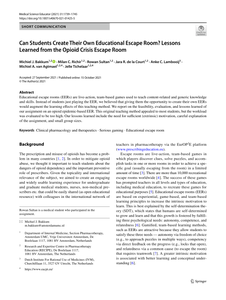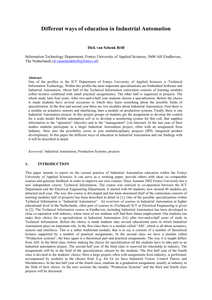Airport management is frequently faced with a problem of assigning flights to available stands and parking positions in the most economical way that would comply with airline policies and suffer minimum changes due to any operational disruptions. This work presents a novel approach to the most common airport problem – efficient stand assignment. The described algorithm combines benefits of data-mining and metaheuristic approaches and generates qualitative solutions, aware of delay trends and airport performance perturbations. The presented work provides promising solutions from the starting moments of computation, in addition, it delivers to the airport stakeholders delay-aware stand assignment, and facilitates the estimation of risk and consequences of any operational disruptions on the slot adherence.
MULTIFILE
Airport management is often challenged by the task of managing aircraft parking positions most efficiently while complying with environmental regulations and capacity restrictions. Frequently this task is additionally affected by various perturbations, affecting punctuality of airport operations. This paper presents an innovative approach for obtaining an efficient stand assignment considering the stochastic nature of the airport environment and emissions reduction target of the modern air transportation industry. Furthermore, the presented methodology demonstrates how the same procedure of creating a stand assignment can help to identify an emissions mitigation potential. This paper illustrates the application of the presented methodology combined with simulation and demonstrates the impact of the application of Bayesian modeling and metaheuristic optimization for reduction of taxi-related emissions.
DOCUMENT
Modern airport management is challenged by the task of operating aircraft parking positions most efficiently while complying with environmental policies, restrictions, schedule disruptions, and capacity limitations. This study proposes a novel framework for the stand allocation problem that uses a divide-and-conquer approach in combination with Bayesian modelling, simulation, and optimisation to produce less-pollutant solutions under realistic conditions. The framework presents three innovative aspects. First, inputs from the stochastic analysis module are used in a multivariate optimisation for generating variability-robust solutions. Second, a combination of optimisation and simulation is used to finely explore the impact of realistic uncertainty uncaptured by the framework. Lastly, the framework considers the role of human beings as the final control of operational conditions. A case study is presented as a proof of concept and demonstrates results achievable and benefits of the framework proposed. The experimental results demonstrate that the framework generates less-pollutant solutions under realistic conditions.
DOCUMENT

Airport management is regularly challenged by the task of assigning flights to existing parking positions in the most efficient way while complying with existing policies, restrictions and capacity limitations. However, such process is frequently disrupted by various events, affecting punctuality of airline operations. This paper describes an innovative approach for obtaining an efficient stand assignment considering the stochastic nature of airport environment. Furthermore, the presented methodology combines benefits of Bayesian modelling and metaheuristics for generating solutions that are more robust to airport flight schedule perturbations. In addition, this paper illustrates that the application of the presented methodology combined with simulation provides a valuable tool for assessing the robustness of the developed stand assignment to flight delays.
DOCUMENT
Assigning gates to flights considering physical, operational, and temporal constraints is known as the Gate Assignment Problem. This article proposes the novelty of coupling a commercial stand and gate allocation software with an off-the-grid optimization algorithm. The software provides the assignment costs, verifies constraints and restrictions of an airport, and provides an initial allocation solution. The gate assignment problem was solved using a genetic algorithm. To improve the robustness of the allocation results, delays and early arrivals are predicted using a random forest regressor, a machine learning technique and in turn they are considered by the optimization algorithm. Weather data and schedules were obtained from Zurich International Airport. Results showed that the combination of the techniques result in more efficient and robust solutions with higher degree of applicability than the one possible with the sole use of them independently.
DOCUMENT

Peer reviewed paper op SEFI Engineering Education congress 2009 In engineering programs an important part of the learning process takes place in practical assignments like capstone projects, internships and co-op assignments in industry. The assignments are very divers. Students have different roles, work in different environments and the learning outcomes are not uniform. So how can the individual learning outcomes or growth competencies of the assignments be determined? To cope with this question the authors developed and implemented a method to monitor and assess the individual learning outcomes of the assignments. The method can be used to match a student to his next assignment in such a way that he can build his individual learning track. The method defines three aspects of an assignment: the role of the engineer (i.e. project leader, designer, researcher), the domain(s) of the assignment (i.e. user interface, software engineering) and a general results matrix that describes results and the level required to produce them. To manage the process learning outcomes are defined as products so project management methods can be used to plan, monitor and assess learning outcomes. Key aspects of the method are: 1. A general results matrix for engineering assignments 2. Learning outcomes that are defined as results in the matrix and these results can be assessed. 3. The results have levels so the learning outcomes can grow during the programme. 4. The method can be used to match, monitor and assess students on one assignment. 5. The method can be used to match, monitor and assess students for the entire programme. 6. The tools that are developed are based on an industry standard for project management.
DOCUMENT

Abstract Educational escape rooms (EERs) are live-action, team-based games used to teach content-related and generic knowledge and skills. Instead of students just playing the EER, we believed that giving them the opportunity to create their own EERs would augment the learning efects of this teaching method. We report on the feasibility, evaluation, and lessons learned of our assignment on an opioid epidemic-based EER. This original teaching method appealed to most students, but the workload was evaluated to be too high. Our lessons learned include the need for sufcient (extrinsic) motivation, careful explanation of the assignment, and small group sizes.
MULTIFILE

This case study describes a special edition of the European Project Semester at the course Sustainable Packaging Design and Innovation at the Faculty of Industrial Design Engineering at The Hague University of Applied Sciences (Fall Semester 2017). In this special edition, unique cooperation took place between 12 parties. The parties were three research institutes, six universities, and three companies. Some parties have developed an educational module focused upon sustainable and circular packaging design, including the use of a dedicated tool for life cycle assessment. This module was embedded in the regular EPS. At The Hague University of Applied Sciences, an international class of 16 students worked in four teams on a real-life design assignment. They were offered a wide range of lectures, workshops, pitches, and presentations. The chapter concludes with a review of the followed processes and organizational, managerial, and practical concerns. Although run as a unique edition, all parties discuss to continue this cooperation.
DOCUMENT

Within the profile Technical Information Technology (ICT Department) the most important specializations are Embedded Software and Industrial Automation. About half of the Technical Information curriculum consists of learning modules, the other half is organized in projects. The whole study lasts four years. After two-and-a-half year students choose a specialization. Before the choice is made students have several occasions in which they learn something about the possible fields of specialization. In the first and second year there are two modules about Industrial Automation. First there is a module on actuators, sensors and interfacing, later a module on production systems. Finally there is an Industrial Automation project. In this project groups of students get the assignment to develop the control for a scale model flexible automation cell or to develop a monitoring system for this cell. In the last year of their studies students participate in a larger Industrial Automation project, often with an assignment from Industry. Here also the possibility exists to join multidisciplinary projects (IPD; integrated product development).
DOCUMENT

Background: Hip and knee osteoarthritis (OA) are highly prevalent worldwide. The guidelines recommend physical activity and education as the core treatments for osteoarthritis. Digital health has the potential to engage people in physical activity and disease management. Therefore, we conducted a pilot trial to assess the usability and preliminary effectiveness of an app-based physical activity and education program (Join2Move) compared to usual care for people with hip and/or knee OA in Germany. Methods: A randomized controlled pilot study was conducted. Individuals with diagnosed or self-reported knee and hip OA were included. Allocation to the intervention or control group was randomized. The intervention group received the Join2Move program. The Join2Move program was previously developed as a website and evaluated in the Netherlands. For the current study, the program was translated and adapted to the German context and adjusted from a website to an app. The control group received usual care. The primary outcomes were usability and preliminary effectiveness (pain and physical functioning). Measurements were taken at baseline and at twelve weeks. The data analysis was performed using SPSS (IBM SPSS Statistics 29.0). Results: Sixty participants, with a mean age of 61.9 (SD ± 7.2) years, were allocated to the intervention (n = 32) or the control group (n = 28) and included in the analysis. The majority of participants had knee OA (68%), and 12% had hip and knee OA. The dropout rate was n = 11 (18%). No adverse events were reported. Usability was rated as acceptable (mean System Usability Scale = 71.3/100) with a wide range (32.5 to 100). Statistically significant between-group differences were found only for pain (mean difference 8.52 (95% CI 1.01 to 16.04), p = 0.027). Conclusions: Join2Move demonstrated acceptable usability. The preliminary results of the pilot trial indicate the potential of a stand-alone app for the treatment of patients with hip or knee OA. However, the acceptable usability of Join2Move limits its recommendation for everyone. There appears to be room for improvement in app usability and in identifying patients for whom the app is suitable and the right time to use a stand-alone app.
LINK